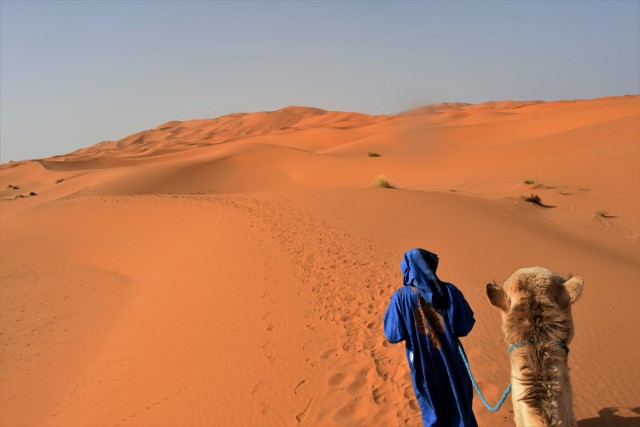Morocco offers the opportunity to visit a country with incredible variety—Atlantic and Mediterranean coastlines, the Rif, Middle and High Atlas Mountain ranges, rich agricultural land, and the Sahara Desert. A visit to Morocco offers ancient and modern cities and small villages, all with incredible architecture, colors, culture, food—and people. Morocco offers the traveler so very much, I highly recommend a visit!
Seeing some of the Sahara Desert, in southeastern Morocco, was high on my list. Happily, the actual experience of seeing the Erg Chebbi sand dunes didn’t disappoint, and while “just” seeing the desert and riding a camel would have been great, there’s so much more to experience of this rich area. Let’s take a look.
Erfoud
The town of Erfoud is our starting point, and we check into our hotel, the Chergui Kasbah, mid-day. We’re greeted by Gnawa musicians and a glass of Moroccan mint tea. Before long, we’re relaxing at the pool with a cocktail. Dinner that night is at the hotel and included all the dishes we’ve been enjoying from the start of the trip—chicken and meat tagines, seafood, brochettes, couscous, wonderfully fresh mezzas, breads, salads and vegetables, and fresh and dried fruits.
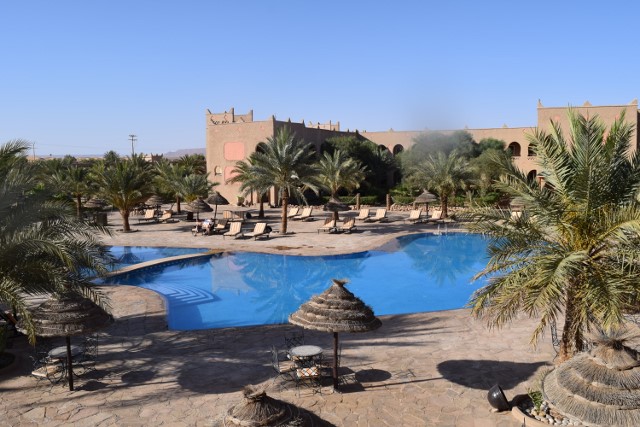
The pool at Hotel Chergui Casbah was refreshing.
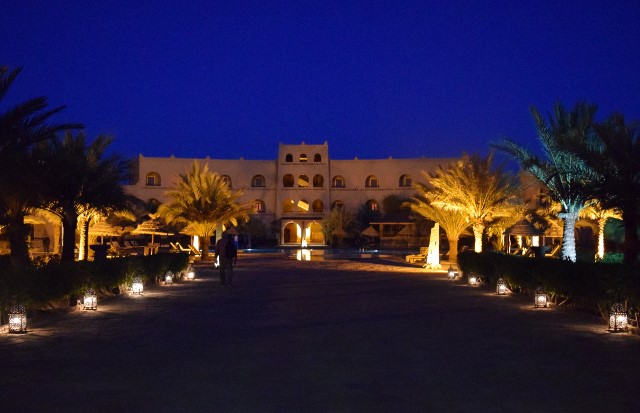
The nights cooled off beautifully.
A visit to one of the many fossil and marble workshops in Erfoud is a great chance to learn more about the geography of the region. (It’s more than just sand!) The area was once a seabed of marine creatures, including trilobites, orthoceras and ammonites (and later, home to dinosaurs as well.) Huge slabs of this stone and marble are quarried, cut, shaped and polished and turned into tabletops, countertops, sinks, fountains, and sculptures, as well as more affordable plates, bowls, pendants, and rocks and fossils.
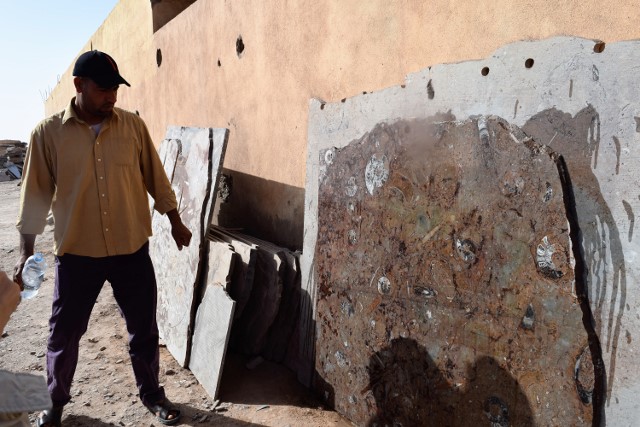
Fossilized marble and rock is found throughout the area.
Take a tour, and see how the finished products are created. Of course, there’s an adjoining shop. (Consider the weight of any purchases, although they’re happy to ship, of course.)
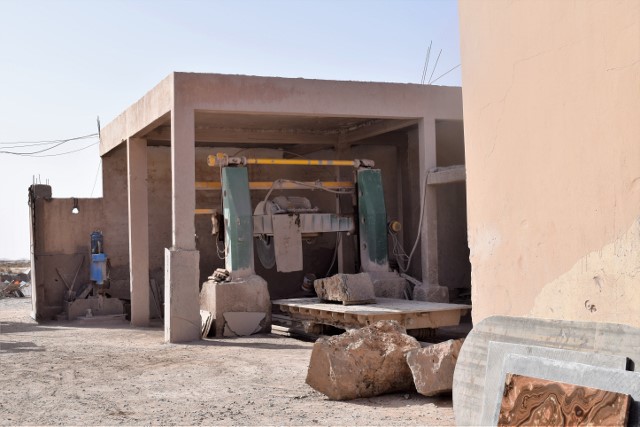
We see how the stone is cut…
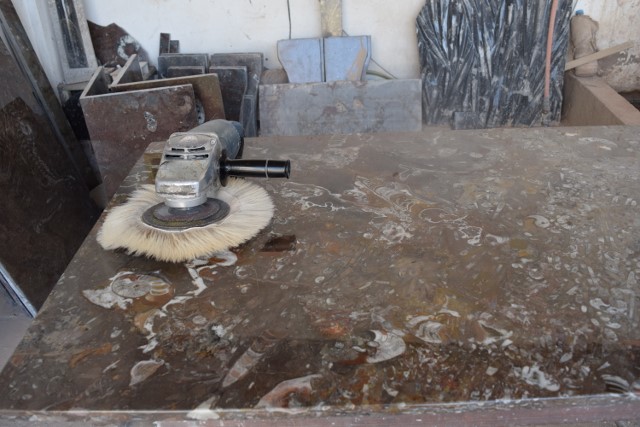
…and polished.
Later in the trip, on a walk, we see some of the same rock still embedded in the ground.
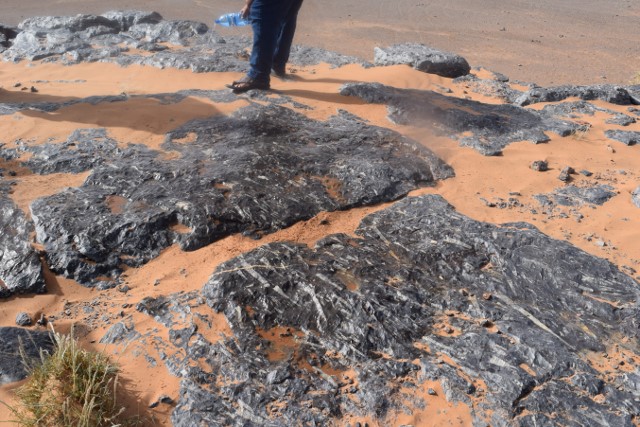
On a desert walk, we see the fossilized rock that’s quarried in the area.
Rissani
In 4×4 vehicles, we drive on to Rissani, about 10 miles away. The drives we take these next two days have us laughing like kids on amusement park rides. We travel on both well-worn paths and totally off-road. The terrain is flat at first, with light sand and black volcanic rock, and spots where we can see for many miles.
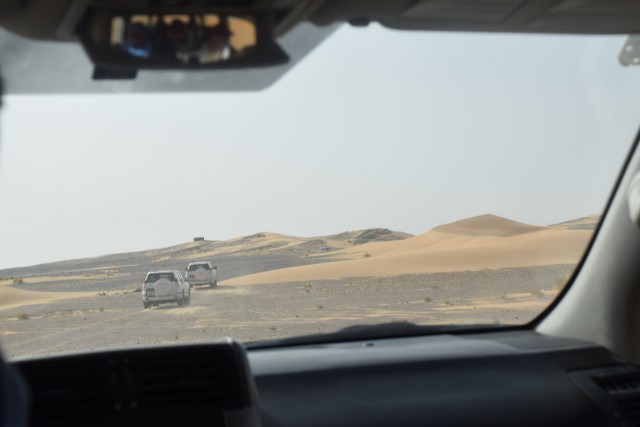
We weave around and over dunes, bopping up and down, all the while passing settlements, bivouacs and nomadic tents, livestock and people.
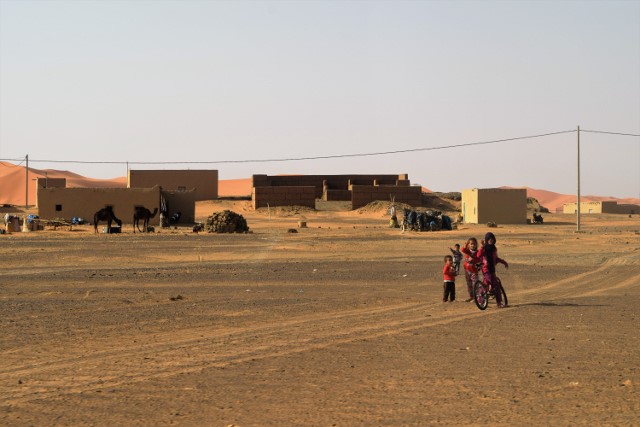
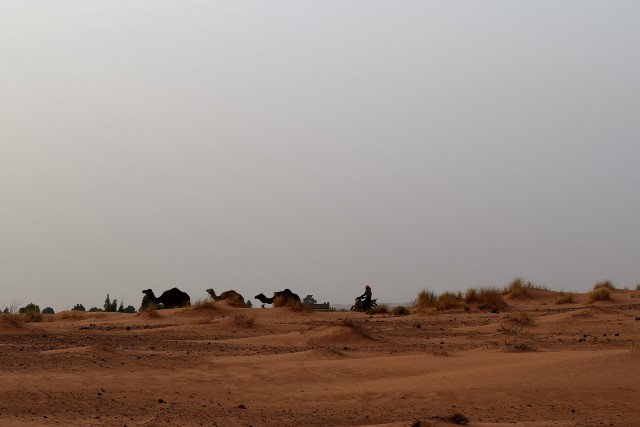
Going home for the night.
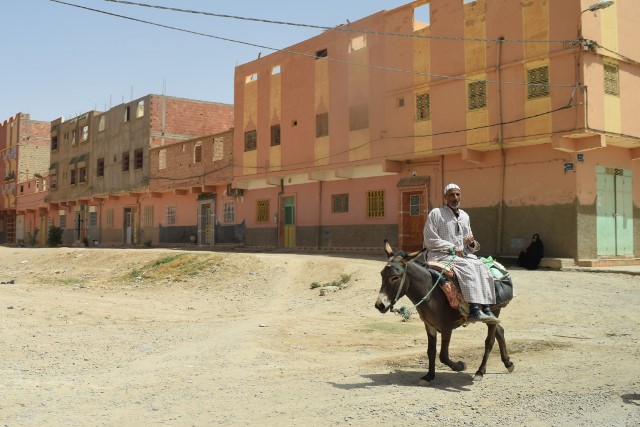
Going up and over the taller dunes blindly was great fun, but we’re really just feeling a sense of wonder of where we are. The variety of what we see is delightful. There’s a little bit of cowboy in our capable drivers, because as often as they drive this area, they have fun with the deep ruts and hills as well. I can only imagine how often the air filters need changing on these vehicles!
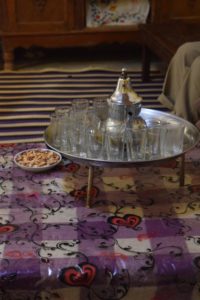
Sweet Moroccan green tea with mint is offered everywhere.
Rissani exists on a site that had been originally founded by Berbers (or more more correctly, the Imazighen or Amazigh people) in the 8th century. The 13th century gate, the Bab Errih, still stands. With our guide as translator, we visit with a family and a couple of her younger children. The woman and her husband, a porter (that is, he delivers goods around the area with a wagon) and the family receive help that allows the children to attend school. Both the government and aid organizations are making a big push to educate children in these rural southern areas. The home is simple and comfortable. She serves us tea and peanuts and shows us how yards of fabric are wrapped to create their clothing.
At a camel milk cooperative, we get to see a mom camel milked while her baby stands by patiently. The warm milk is sweet and custardy. Yogurt made from the milk is especially good. Camel milk is highly nutritious, stays fresher longer than cow’s milk and is an important food source in the area. (Camel meat is popular as well, of course.) Date nut coffee and other local products from local cooperative farmers are also available.
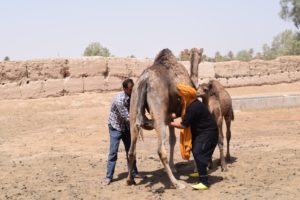
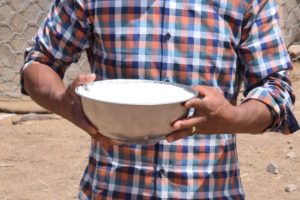
Base Camp
Outside of the town of Merzouga, we enter our camp, where we plan to spend the next two nights. (Merzouga has plenty of hotels for tourists coming to see the Erg Chebbi dunes and there are also many different camping outfitters, with all levels of basic and luxury camping options.)
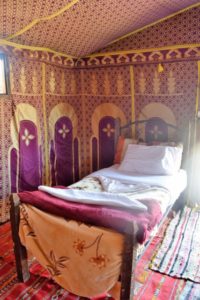 Our (permanent) camp is pretty darned cushy. It consists of a semi-circle of 12 housing tents capped by a larger dining tent, and behind this, a cooking tent and tents for our drivers and the camp staff. The tent exteriors are made from camel wool canvas and held secure with wood posts. A menagerie of carpets create the floor. The interior walls of the tent are lined with red and gold drapery fabric. There’s a light switch for the Moroccan lantern that hangs in the center of the tent, and a charger plug. My tent has a single bed, laden with wool blankets, while some rooms have queen beds. There’s also an iron coffee table and two iron bistro chairs.
Our (permanent) camp is pretty darned cushy. It consists of a semi-circle of 12 housing tents capped by a larger dining tent, and behind this, a cooking tent and tents for our drivers and the camp staff. The tent exteriors are made from camel wool canvas and held secure with wood posts. A menagerie of carpets create the floor. The interior walls of the tent are lined with red and gold drapery fabric. There’s a light switch for the Moroccan lantern that hangs in the center of the tent, and a charger plug. My tent has a single bed, laden with wool blankets, while some rooms have queen beds. There’s also an iron coffee table and two iron bistro chairs.
Front and back doorways include both screen and cloth zipped closures, for both air circulation and privacy. At the back door, the tent has been extended with plastic walls and a concrete base and slatted wood floor to enclose a flushing toilet on one side and a sink and shower on the other, both of which have both cold and hot running water from the wells in the area. The sink is brass and the little makeshift shelf over the sink is fossilized marble. There light switches with overhead light bulbs. (The camp is solar-powered.)
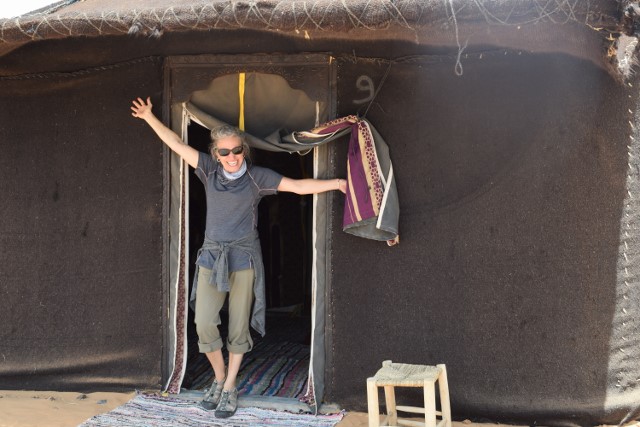
Not your average camping experience.

We settle in, popping in and out of each others’ tents to compare notes, and head over to the dining tent for lunch. Tables are fully laid; there’s even stemware for the wine we brought along. And the food is delicious. Again, you’ll eat well in Morocco; the vegetables are always plentiful and seasonal and fresh and the spices and flavors are fabulous. And good food cooked in a camp is no easy feat. Below are just a few of the great dishes we enjoyed.
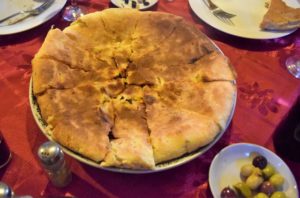
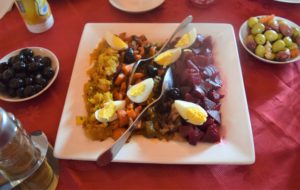
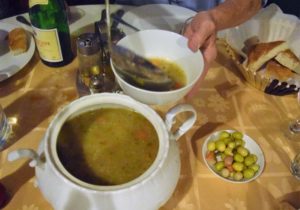
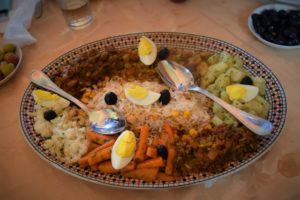
Visiting with Nomads
We head out to visit a date farm, but first make an impromptu stop at a nomad family’s tent.
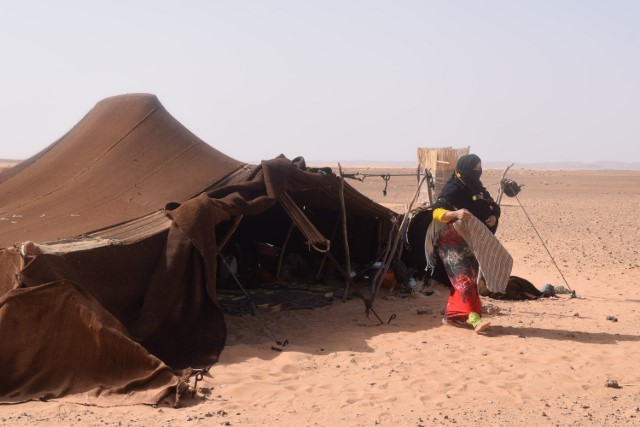
We’re invited inside the tent and through our guide, Mohamed, we learn she’s a widow of 14 years, with a herd of five camels and 10 goats. She wasn’t sure how old she was, but thought around 45 years old. Married at 13 and had been widowed for 14 years. She lives in the tent (which they made) with her youngest daughter and a son, his wife and their child. And while she enjoys going into the city and would like to move there, but she wants to remain near her children.
The family is Amazigh, and like most we meet, she speaks both Berber and Arab. Likewise, she won’t remarry because she wants to safeguard ownership of her herd of animals for her children. All of her children have remained in the nomadic way of life and she believes her grandchildren (she has only the one currently) will also live a nomadic life.
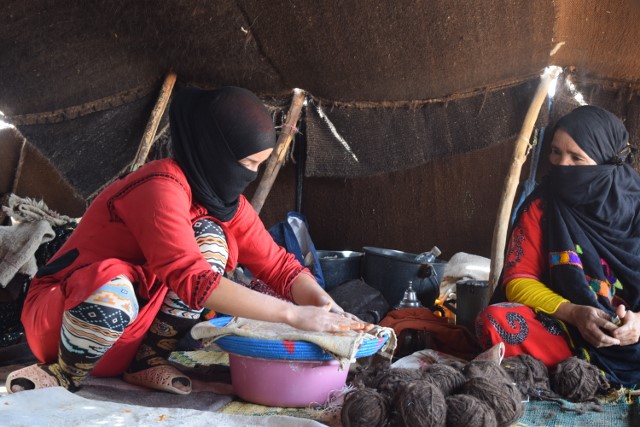
The women share glimpses of their daily life and thoughts about life in the desert.
Water is life in the desert and she tells us they will walk two or three hours to get water from the public wells. She expects they’ll stay in this spot for one or two months. Her son is currently out looking for a better area for water and for the camels. As we speak, she shows us how she makes yarn from camel hair, while her daughter makes bread and cooks a mixture of spiced vegetables in a clay oven just outside the tent. Back in the tent, she assembles the dish, arranging the vegetables onto one disk of dough and covering it with a second; making essentially a stuffed pizza, then cooking it in the oven.
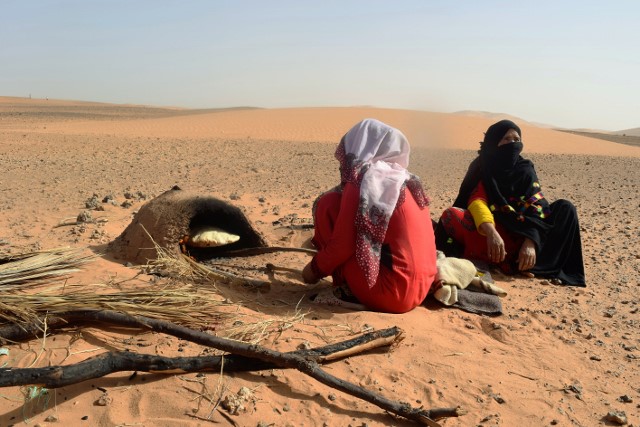
Nomadic women bake stuffed bread in the oven just outside their tent.
They share the dish with our group and with our drivers, and it’s delicious.
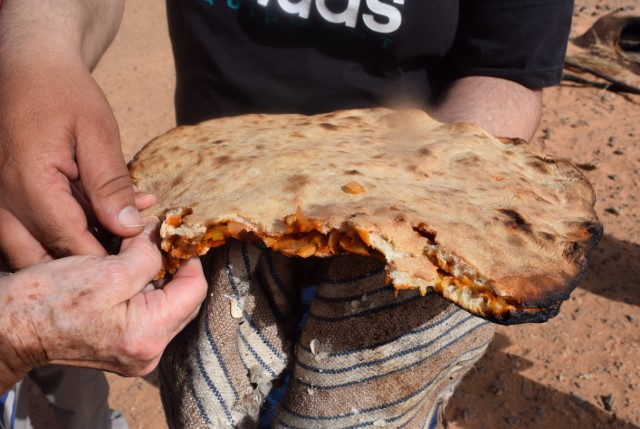
Our Amazigh (Berber) hosts share their dinner with us.
Date Farm Visit
Dates are an important crop in the Sahara. Each tree can produce between 220 and 440 pounds of dates, with Medjool dates being the most prized variety. We arrive at a date palm tree farm and meet the owner, a former nomad, who has been farming his land since 1985. His farm is prosperous, with several homes for family members and free-roaming goats, chickens and donkeys.
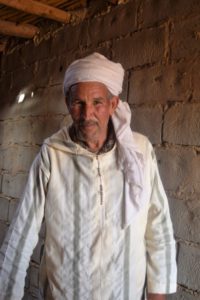
A former nomad, he now owns a successful date farm.
He tells us about how the wells were dug—at first only salt water could be found; but now he has a fresh water system for drinking and irrigation. He shows us the pump house that carries water to ditches alongside the rows of about 250 female, fruit producing trees.
He’s eager to share and has a great smile. “The kitchen is a pharmacy for us,” he says, and speaks of the medicinal properties of paprika, ginger and cumin. He raises five different types of dates, and talks with us (again, through our guide) about propagation and the other crops they grow for family food. He even climbs one of the palm trees to show us how the fruit is harvested.
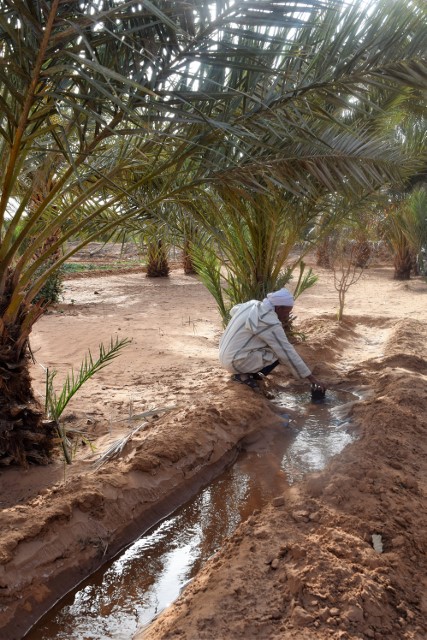
Irrigating the date palms is important to the crop’s success.
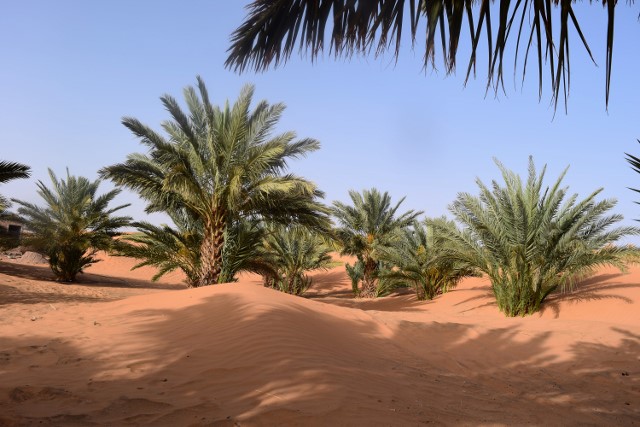
Date palms.
He lives here with his children and their families. As we leave, he scoops up a young granddaughter and carries her in a comfy little ball, while two of his grandsons tag along.
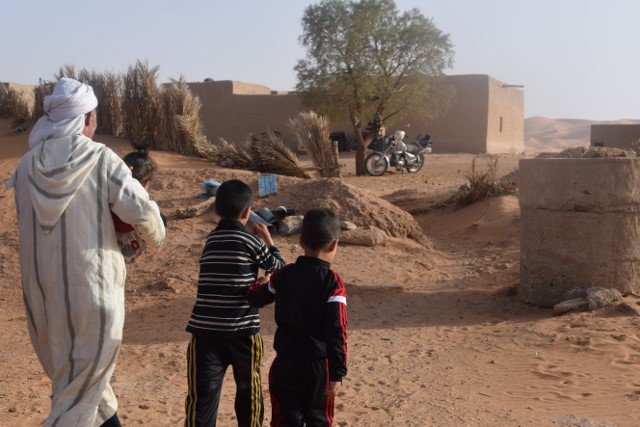
Sunset, Stars, and Sunrise
Back in camp, we watch the sun set over the dunes.
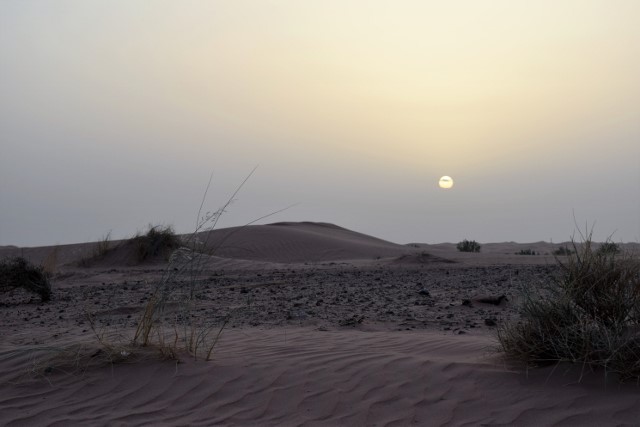
And in the middle of the night, we wake to see the star show in the sky—and it is spectacular! I’ve been treated to brilliant, star-filled skies before, but the “entire” Milky Way is not something you see often. That brilliant expanse of light and space truly is awe-inspiring.
Of course, we also wake early to enjoy a great sunrise over the dunes. My photos don’t do it justice; it’s just one of those things I’m thrilled to have the opportunity to experience.
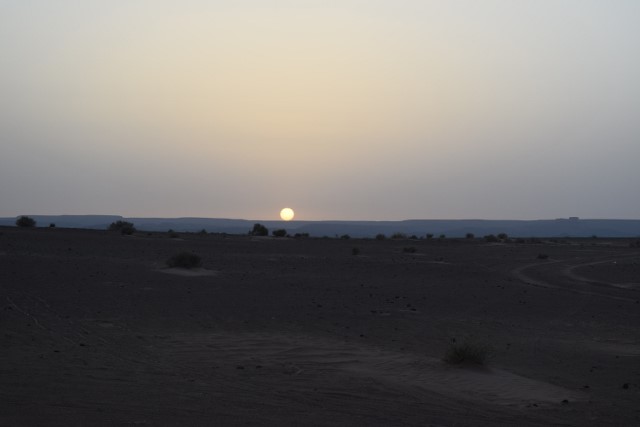
Watching the sun rise over the desert sky.
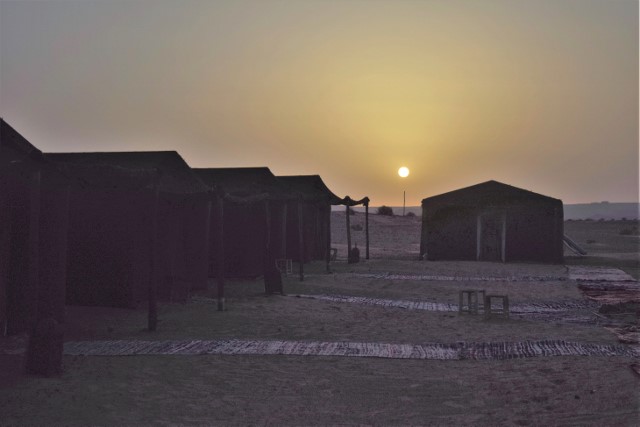
The sun rises over camp.
Camel Ride!
After breakfast, we head out for our camel ride. The camels are all the more common dromedaries, and you get on them from a sitting position, then lean way back in the saddles as they stand up. They’re surprisingly peaceful and quiet and relaxed and enjoyable to be with.
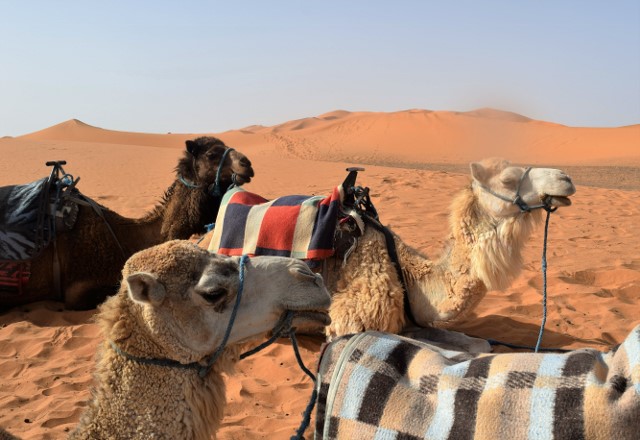
The views are even better than I had imagined. The sand dunes of Erg Chebbi rise 500 to 800 feet high and extend close to the Algerian border.
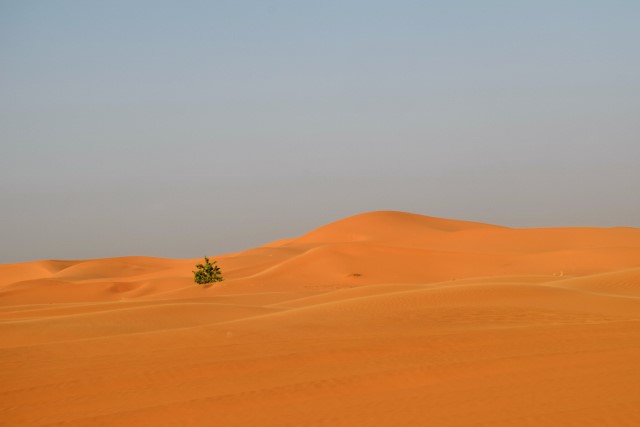
The sand dunes of Erg Chebbi.
Sand dunes as far as the eyes can see. Great photos opts and laughs and friendly guides. A great time with these wondrous animals!
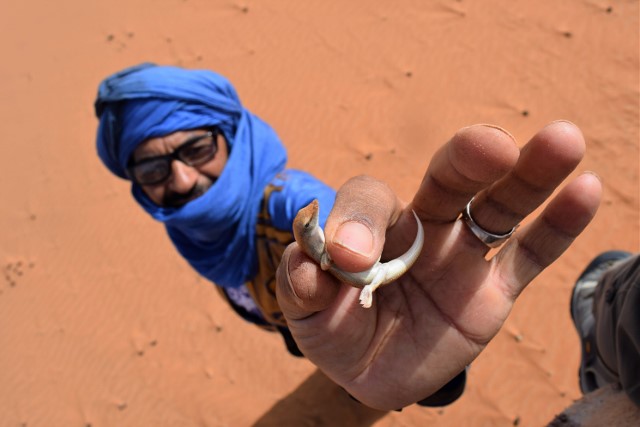
A Saharan sand salamander.
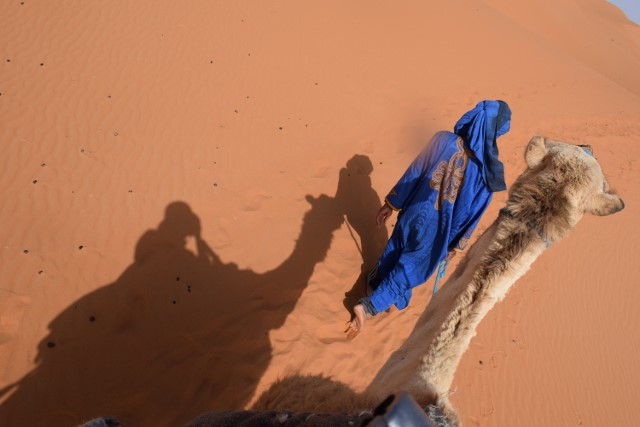
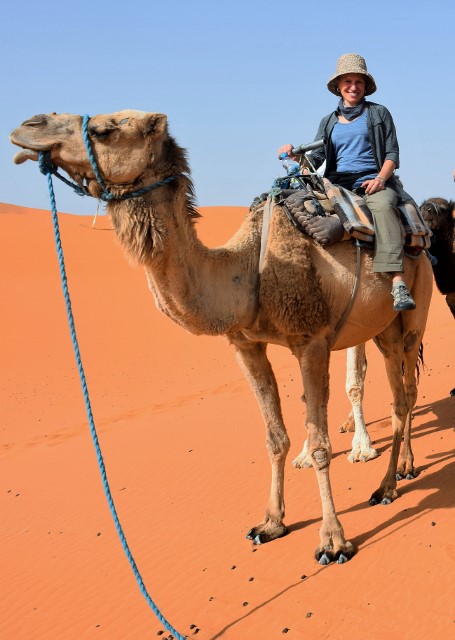
Khamlia
As temperatures rose, we drive to Khamlia, a small and quite remote village with about 150 residents. There, we visit two schools; a kindergarten and an elementary school. The kids were eager for visitors, and the fist bumps from the smallest kindergartners were endearing.
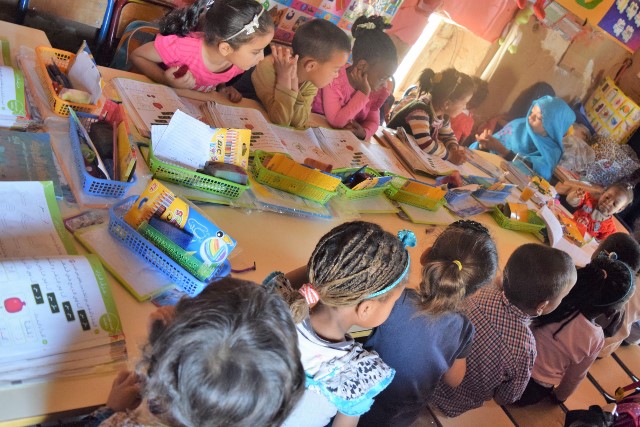
Kindergartners in Khamlia.
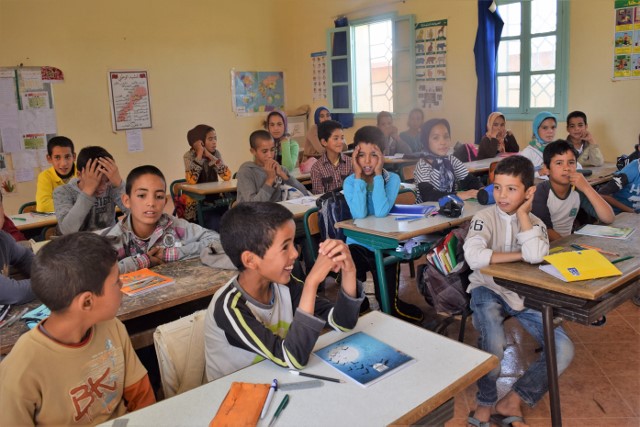
Our visit brought laughs from the elementary students.
Tourism definitely brings dirhams, the Moroccan currency, to the area. In addition to camel rides, ATV rides, and camping, visitors arrive interested in seeing a bit of village life and to hear music from Pigeons du Sable, the well-regarded Gnaouan musical group. Before the music, we’re welcomed as we are most anywhere; with a glass of Moroccan mint tea.
The Gnaouan Musicians of Khamlia
Moroccan Gnaoua (Gnawa) songs and rhythms originally were played for specific celebrations and healing or religious purposes with ties to Maghreb Sufis and Sub-Saharan pre-Islamic times. There’s chanting and singing and percussion instruments, including drums and iron cymbals called krakebs (or qraqab), as well as a three-stringed lute called a gimbri or sinter. The music is played for its own sake now, and is even going into more modern, jazz-like directions as well. There are festivals and increasingly, opportunities to hear the music around the world.
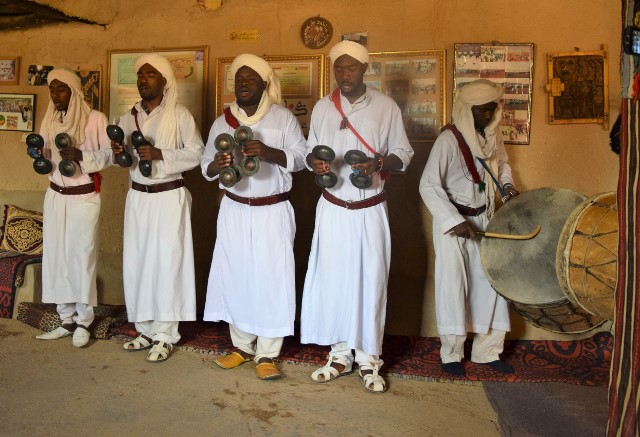
Gnaoua music is intoxicating in its beats and rhythms.
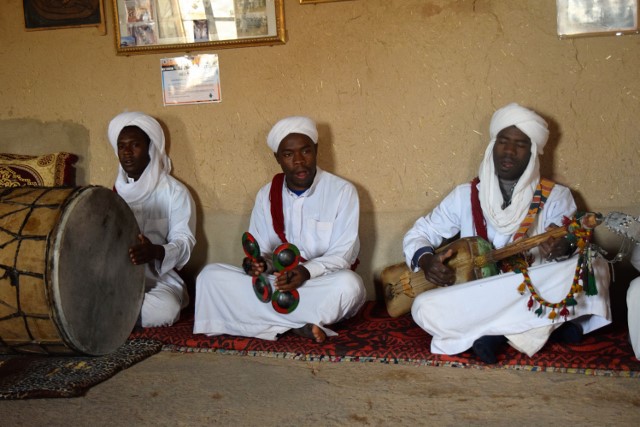
Percussion and stringed instruments, as well as singing and chanting are part of Gnaoua music.
Cooking Lesson
The afternoon sun is hot. Back in camp, we read, write, or sleep before rejoining for a talk on Islam and a cooking lesson from our camp cook, learning how to assemble a chicken and vegetable tagine.
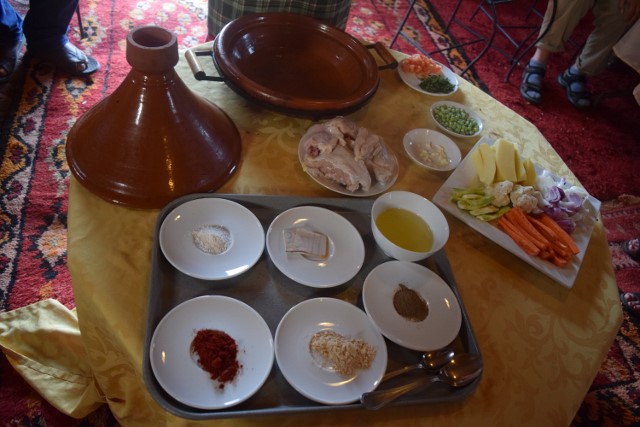
After dinner, we break off for a walk and enjoy the cooler temps before gathering again at the fire pit for some music and dancing.
A Memorable Experience
Leaving the desert to continue the journey west toward Ouarzazate, my skin is covered in a gritty layer of salty sand. Another good scrubbing and the sand will wash away, but the chance to experience this fascinating North African Islamic country, the memories of all I’ve seen, and the people I’ve met will remain.
For More:
- Chergui Kasbah, Erfoud, https://www.hotelchergui.com/en/
- Pigeons du Sable, Khamlia, https://www.khamliatour.com/pigeons-du-sable-3/?lang=en
- Visit the official Moroccan Tourism site, https://www.muchmorocco.com/
- Right here, at Confetti Travel Cafe: On Moroccan riads and on Moroccan ceramic and tile work
- Overseas Travel Adventures (OAT), oattravel.com. I made part of this trip to Morocco with OAT. While I’ve always been an independent traveler, I’m attracted by the emphasis on getting to know the people and culture of a place and the lack of a single supplement for solo travelers. Providing this code when you book your trip (#002665715) will get us both a discount.
-All photos by Nancy Zaffaro.

